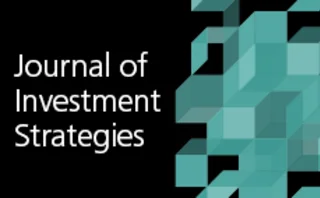Technical paper
Distortion risk measures for nonnegative multivariate risks
In this paper, the authors present a way to address multivariate distortion risk measures and give some examples of distortion functions and distributions where the final expression has a closed form.
The predictability implied by consumption-based asset-pricing models: a review of the theory and empirical evidence
This paper examines whether two well-known models, Campbell and Cochrane’s habit model and Bansal and Yaron’s long-run risks model, can produce significant return predictability.
Curve dynamics with artificial neural networks
Artificial neural networks can replace PCA for yield curves analysis
Does the impact of exchange-traded funds flows on commodities prices involve stockpiling as a signature? An empirical investigation
This paper examines the relation between the flows into the three main commodity index exchange-traded funds (ETFs) and the prices, inventory and term structure of four energy and twelve US-traded agricultural contracts.
Measuring system-wide resilience of central counterparties
This paper describes the three components needed to simultaneously stress clearing members and CCPs across markets: scenario generation, evaluation of the profit and loss (P&L) of clearing member portfolios for each scenario, and default of clearing…
An operational risk capital model based on the loss distribution approach
In this paper, the author constructs a capital model for operational risk based on the observation that operational losses can, under a certain dimensional transformation, converge into a single, universal distribution.
Consumer risk appetite, the credit cycle and the housing bubble
In this paper, we explore the role of consumer risk appetite in the initiation of credit cycles and as an early trigger of the US mortgage crisis.
Importance sampling applied to Greeks for jump–diffusion models with stochastic volatility
In this paper, the authors develop a procedure to reduce the variance when numerically computing the Greeks obtained via Malliavin calculus for jump–diffusion models with stochastic volatility.
Impact of D-vine structure on risk estimation
In this paper, a sensitivity analysis using pair–copula decomposition of multivariate dependency models is performed on estimates of value-at-risk (VaR) and conditional value-at-risk (CVaR).
Credit default prediction using a support vector machine and a probabilistic neural network
In this study, the authors address the fact that the ranking of classifiers varies for different criteria with measures under different circumstances, by proposing the simultaneous application of support vector machine and probabilistic neural network …
Smoothing algorithms by constrained maximum likelihood: methodologies and implementations for Comprehensive Capital Analysis and Review stress testing and International Financial Reporting Standard 9 expected credit loss estimation
In this paper, the author proposes smoothing algorithms that are based on constrained maximum likelihood for rating-level PD and for rating migration probability.
Discrete time stochastic volatility
Quant proposes faster model to price arbitrage-free swaptions
One for my baby (and one more for the road): incentives, default waterfalls and central counterparty skin-in-the-game
In this paper, the authors argue that both for-profit central counterparties and their clearing members should contribute to the default waterfall, with a CCP’s two contributions coming directly before and directly after the tranche of clearing member…
Modeling very large losses
In this paper, the author presents a simple probabilistic model for aggregating very large losses into a loss collection.
Pricing multivariate barrier reverse convertibles with factor-based subordinators
In this paper, the authors study factor-based subordinated Lévy processes in their variance gamma (VG) and normal inverse Gaussian (NIG) specifications, and focus on their ability to price multivariate exotic derivatives.
Hybrid finite-difference/pseudospectral methods for the Heston and Heston–Hull–White partial differential equations
In this paper, the authors propose a hybrid spatial finite-difference/pseudospectral discretization for European option-pricing problems under the Heston and Heston–Hull–White models.
The CoCVaR approach: systemic risk contribution measurement
In this paper, the authors propose a measure for systemic risk, CoCVaR, the conditional value-at-risk (CVaR) of the financial system conditional on an institution being in financial distress.
Genetic algorithm-based portfolio optimization with higher moments in global stock markets
This paper investigates the distributional characteristics of stock market returns and analyzes the significance of higher moments.
Monitoring transmission of systemic risk: application of partial least squares structural equation modeling in financial stress testing
This paper illustrates how the transmission of systemic risk from shadow banking to the regulated banking sector can be modeled using partial least squares structural equation modeling in an effort to help regulators better monitor and manage contagion.
Debt, information asymmetry and bankers on board
This paper contributes to the financial networks literature by providing evidence that well-connected bankers on the boards of directors of nonfinancial firms reduce information asymmetry between credit markets and firms.
News-sentiment networks as a company risk indicator
This paper defines an algorithm for measuring sentiment-based network risk, to understand the relationship between news sentiment and company stock price movements, and to better understand connectivity among companies.
Risk-averse dynamic arbitrage in illiquid markets
This paper introduces the concept of risk-averse dynamic arbitrage using a general time-consistent dynamic risk measure and a risk-aversion threshold level.
Reflections on recent volatility
This paper deals with the unprecedented equity volatility in the second week of February 2018. The paper recaps the week, places the market movement in a historical context, discusses how some traders and funds were affected and offers a few guesses as…
The Kelly criterion in portfolio optimization: a decoupled problem
This paper examines how the Kelly criterion can be implemented into a portfolio optimization model that combines risk and return into a single objective function using a risk parameter.











